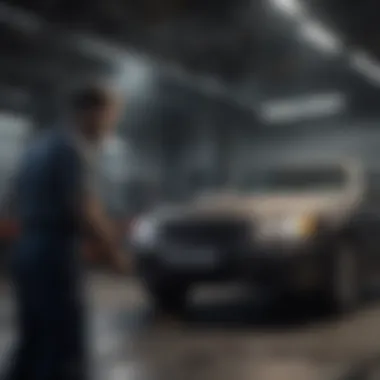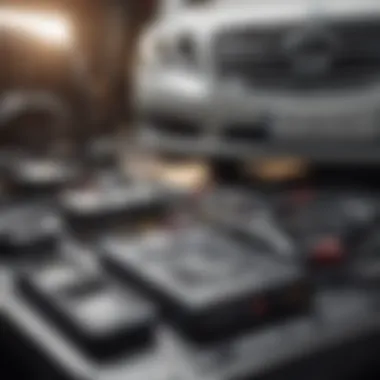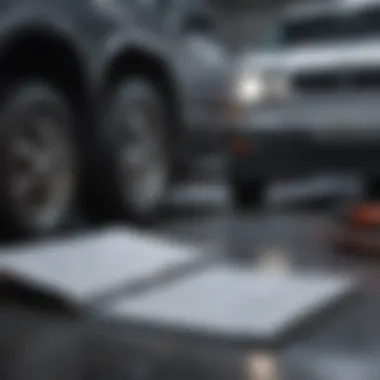The Importance of Mechanics in Vehicle Inspections


Intro
In the intricate tapestry of vehicular maintenance, mechanics play a pivotal role that goes well beyond mere repair work. Completing a vehicle inspection is not just about checking off boxes on a service list; it's a comprehensive evaluation that can significantly impact safety, performance, and even the lifespan of the vehicle itself. This article embarks on a detailed journey into the multifaceted responsibilities of mechanics during these inspections, touching on the powerful tools and modern technologies they utilize. With the ever-present emphasis on safety and efficiency, understanding how mechanics contribute to these aspects can empower vehicle owners to make informed decisions.
As the wheels of technology continue to roll forward, establishing a solid relationship with a skilled mechanic is a step toward ensuring that both vehicles and their drivers remain protected on the road. Let us start by examining performance metrics, one of the foundational elements assessed during vehicle inspections.
Understanding Vehicle Inspections
Vehicle inspections are like a health check-up for your car, ensuring it's safe and running smoothly. Regular inspections not only protect your well-being on the road but also help maintain your vehicle's performance over time. Think of them as a proactive measure, rather than simply waiting for something to break down before taking action. The mechanics' expertise in these inspections can lead to cost savings and extended vehicle life, seen as two sides of the same coin.
Importance of Regular Inspections
One cannot stress enough how essential regular inspections are. They serve as a preventive strategy. Imagine driving down the highway, smooth sailing, when suddenly, you hear a strange noise or the brakes start to feel off. It can be a life-changer, right? Regular inspections help in spotting these issues before they escalate. A well-maintained vehicle not only performs better but also retains its value in the long run. And consider this: many insurance policies might offer discounts if you can prove your vehicle is regularly inspected.
Types of Vehicle Inspections
Various types of inspections cater to different needs. This helps owners stay informed and avoid potential pitfalls. Below, we delve into the distinct categories of vehicle inspections:
Pre-purchase Inspections
Pre-purchase inspections are, without a doubt, a prudent choice for anyone buying a used vehicle. It provides an in-depth look at the condition of the car before making that financial leap. A mechanic will check numerous components, from the engine to the suspension, ensuring no hidden issues lurk beneath the surface. This inspection gives the buyer peace of mind, making it a popular option. However, it’s crucial to ensure the mechanic's experience, as the value of this inspection can vary based on the mechanic’s ability to identify problems. On the downside, this extra step can add to the overall cost, yet it often saves money in the long run by preventing bad investments.
Routine Maintenance Checks
Routine maintenance checks work like clockwork; they keep the engine running smoothly. Think oil changes, tire rotations, and fluid top-offs. These checks usually occur every few months, depending on the vehicle and usage. They are a proven method to catch small issues before they snowball into larger, more expensive repairs. The regularity can greatly enhance vehicle performance. Neglecting these checks can lead to unforeseen breakdowns; nobody wants to end up stranded on a busy road.
Safety Inspections
Safety inspections ensure your vehicle meets government regulations and personal safety standards. They are often mandatory in many jurisdictions. The mechanic examines brakes, lights, steering, and tires to ensure everything is up to snuff. A vehicle that passes a safety inspection not only provides peace of mind to the owner but also signifies compliance with state laws. Neglecting to have these inspections done could lead to hefty fines or legal trouble.
Emissions Testing
Emissions testing focuses on your vehicle's environmental impact. It checks exhaust emissions to ensure that the vehicle complies with local laws on air pollution. This testing is critical in urban areas, where smog might be a concern. A vehicle that fails its emissions test might face costly repairs to adhere to standards, but passing the test can also lead to transparency and accountability in vehicle operation. Citizens can breathe easier knowing that vehicles on the road are less polluting, contributing to a cleaner environment, while on the flip side, those who disregard testing may face financial penalties.
Regular vehicle inspections can save money and lives. Ignoring them is like playing Russian roulette with your car's safety and performance!
The Mechanic's Role in Inspections
The mechanics play a crucial role in vehicle inspections, a fundamental aspect that ensures vehicles operate safely and efficiently. These skilled individuals not only perform routine checks but also delve deep into the heart of vehicles, identifying potential issues that could lead to costly repairs or accidents down the line. Their expertise is invaluable in maintaining the overall integrity of the vehicle, helping to avoid dangerous situations on the road and ensuring longevity for the automobile.
Training and Qualifications
Mechanics are not just those who tinker with engines; their skills come from rigorous training and qualifications that equip them for the complexities of modern vehicles. Understanding the depth of their training can help anyone appreciate the layer of expertise behind a vehicle inspection.
Certification Programs
Certification programs are what set the standard for a mechanic's qualifications. These programs often require a culmination of classroom learning and hands-on experience, culminating in a certification exam that covers areas such as electronics, diagnostics, and specific vehicle systems. One standout characteristic of these programs is their adherence to industry standards, ensuring that technicians meet the necessary criteria to perform inspections. This structure makes them a popular choice for aspiring mechanics, as they provide a clear pathway into the profession.
However, while certifications are beneficial, they often come with limitations, particularly concerning the types of vehicles or systems that a certified mechanic can inspect. This can sometimes hinder a mechanic's ability to work across various manufacturers or specialties.
Apprenticeships
Apprenticeships offer a different route, emphasizing on-the-job training alongside experienced professionals. These hands-on experiences allow mechanics to learn in real-world settings, which can be invaluable. The key characteristic of apprenticeships is that they blend formal education with practical experience, making them a beneficial choice for many who want to enter the industry.


Unique to apprenticeships is the mentor-student relationship, where a seasoned mechanic can impart not just technical skills but also industry insights. This personal touch is sometimes missing from purely classroom-based training programs. However, the downside is that apprenticeships can be time-consuming, often lasting several years before a mechanic is fully trained.
Continuous Education
Once mechanics have entered the field, continuous education becomes vital for their career progression. Technologies are ever-evolving, and what was standard last year may be outdated today. Continuous education helps mechanics stay abreast of the latest developments in vehicle technology and inspection techniques, which underpin their critical role in inspections today.
The unique feature of continuous education is its focus on lifelong learning. Workshops, seminars, and online courses allow mechanics to refine their skills and expand their knowledge base. The downside might be the cost associated with these courses, but the benefits generally outweigh the expenses over time, as they lead to more efficient and accurate inspections.
Key Responsibilities
Mechanics have a diverse array of responsibilities during vehicle inspections. Their insights and actions contribute directly to the safety and performance of the vehicles they assess. Understanding their main duties is key to appreciating their role.
Identifying Mechanical Issues
Identifying mechanical issues is arguably one of the most critical tasks a mechanic undertakes during an inspection. This process involves scrutinizing every aspect of the vehicle, from the engine to the brakes, to pinpoint any anomalies. A mechanic's keen eye and trained instincts allow them to catch potential problems before they escalate.
The key characteristic of this responsibility is its preventative nature. Rather than waiting for a vehicle to break down, mechanics actively seek out and address issues. This approach can save vehicle owners significant time and money down the line. However, the complexity of some mechanical systems can sometimes hinder quick or accurate identification of problems, placing pressure on even the most skilled technicians.
Performing Diagnostic Tests
Performing diagnostic tests represents a more technical side of mechanics' responsibilities. These tests utilize specialized equipment to assess various systems within the vehicle, generating data to understand its condition better. This layer of diagnostics not only confirms what a mechanic might observe visually but also reveals hidden issues that require attention.
Diagnostic tests are beneficial because they provide objective data that can help owners make informed decisions about repairs and maintenance. The intricacies of this process can be a double-edged sword; while diagnostic tools can reveal critical issues, they are only as good as the technician interpreting the results.
Providing Maintenance Recommendations
Finally, providing maintenance recommendations is a cornerstone of a mechanic's role in inspections. After thorough assessments, mechanics often advise owners on necessary repairs and routine maintenance to keep vehicles in top shape. This advisory facet is crucial for vehicle longevity and safety, reinforcing the mechanic's role as a trusted advisor.
The unique aspect here lies in the relationship between the mechanic and the vehicle owner. A good mechanic goes beyond simply stating what’s wrong; they explain why certain repairs are necessary and how neglecting them can lead to bigger problems. This relationship can be challenging at times, especially when costs escalate, but effective communication can mitigate disagreements.
"A stitch in time saves nine" is a saying that perfectly embodies the role of mechanics in vehicle inspections. Their preventive measures can save drivers from major headaches on the road.
Inspection Tools and Technologies
In the realm of vehicle inspections, tools and technologies play a pivotal role in ensuring that mechanics can carry out their assessments accurately and efficiently. Without the right equipment, even the most skilled mechanic would struggle to identify issues swiftly. This section provides insight into the traditional and emerging tools that mechanics employ, revealing their importance in maintaining vehicle safety and performance.
Traditional Inspection Equipment
Hand Tools
Hand tools are the backbone of any mechanic’s toolkit. These tools are versatile and straightforward, allowing mechanics to perform a variety of tasks ranging from basic repairs to detailed inspections. A wrench set is a quintessential example. It's classic, yet effective. The simplicity of hand tools is perhaps their greatest allure. They often do not require fancy technology or training to use, making them accessible to both seasoned professionals and amateurs alike.
However, while they are invaluable, hand tools do have limitations. For instance, they might not provide the precision that some diagnostic procedures require. Yet, one cannot overlook their durability and control. A mechanic can have a tactile feel for the job, leading to more personalized care when working on a vehicle.
Diagnostic Scanners
When it comes to modern inspections, diagnostic scanners are a game changer. These devices hook up to a vehicle’s onboard computer systems and retrieve information that mechanical systems relay. This means that mechanics can tap into a repository of data revealing underlying issues without having to disassemble the vehicle. The standout feature of these scanners is their ability to provide real-time feedback.
Their widespread popularity stems from their efficiency in narrowing down problems quickly. However, over-reliance on these scanners can lead to a lack of hands-on experience. Mechanics might sometimes miss out on simpler mechanical failures if they depend solely on digital data. Balancing the use of diagnostic scanners with traditional inspection methods can yield the best results.
Brake and Suspension Testing Tools
Brake and suspension testing tools are essential for ensuring that a vehicle can stop effectively and maintain stability. These tools allow mechanics to evaluate brake performance, shock absorber functionality, and alignment setups. They play a critical role in identifying issues that could affect safety while driving.


A primary characteristic of these tools is their emphasis on safety. By using systems that simulate real driving conditions, mechanics can detect problems that may not show up during a standard inspection. However, the unique nature of these testing tools often means they can be more expensive and require specialized training to operate.
Emerging Technologies in Vehicle Inspections
Mobile Inspection Apps
With technology on the rise, mobile inspection apps have become an essential tool in the mechanic's arsenal. These applications offer mechanics the flexibility to conduct inspections on the go. They can upload findings, generate reports, and maintain communication with customers instantaneously. One highlighted feature is the ability to take photos and attach them to inspection reports. This adds a layer of transparency between the mechanic and the vehicle owner.
However, while they bring convenience, dependency on mobile apps can lead to issues, especially if mechanics encounter poor cellular service. The integration of such technology should be balanced with traditional methods to ensure comprehensive assessments.
Advanced Diagnostic Software
Advanced diagnostic software goes beyond standard diagnostic scanners. This kind of software allows for deeper insights into a vehicle’s performance, particularly for modern cars equipped with complex computer systems. A notable feature is the predictive analysis capability that can forecast potential future issues based on current performance metrics. It makes the job of a mechanic a lot easier by presenting a broader picture.
There are, however, drawbacks. These systems can become costly and may require regular updates to deal with new vehicle models and systems. Mechanics must be adept at understanding both software and hardware to make the most effective use of this technology.
Telematics and Real-time Data Monitoring
Finally, telematics and real-time data monitoring represent the leading edge of vehicle inspection technologies. Telematics enable constant communication between vehicles and mechanics, allowing for preventive maintenance based on real-time data. This means issues can be flagged before they become severe problems.
However, the complexity of telematics can also pose a challenge. Not all mechanics have the skills needed to interpret the vast amounts of data these systems produce. Essential components or systems may require further verification through traditional inspection methods. Still, as vehicles become increasingly equipped with advanced systems, telematics will likely become indispensable in the field.
Selecting the Right Mechanic for Inspections
Choosing the right mechanic for vehicle inspections is a decision that carries weight, much like selecting the right doctor for health check-ups. The right mechanic goes beyond just knowing how to turn a wrench; they should embody a mix of skill, experience, and a solid reputation. The repercussions of this choice can ripple through your vehicle’s long-term health and performance. So how do you go about making this important choice? Let’s unpack the key elements to consider.
Evaluating Experience and Reputation
When it comes to evaluating a mechanic, their experience in handling different types of vehicles and their reputation within the community serves as a solid foundation for your decision. It's essential to ask questions about their background: How long have they been in the business? Have they worked on vehicles like yours? A mechanic with experience understands the nuances of various systems, from old vintage cars to modern hybrids.
In addition, don't underestimate the power of word-of-mouth. Pundits and local review sites often reveal insights you won’t find in a brochure. Positive testimonials and high ratings signal reliability, but a few unfavorable reviews may also spotlight potential pitfalls. Ultimately, a mechanic's reputation can be the icing on the cake or a red flag in disguise.
Understanding Pricing Models
Navigating the financial aspect of vehicle inspections can feel like walking on a tightrope. Different pricing models exist, each with its own set of advantages and pitfalls that can directly affect your wallet.
Flat Rate vs. Hourly Charges
Flat rate and hourly charges stand as two primary methods of determining how much you’ll fork over for an inspection. Flat rates tend to provide a fixed price for specific services. This can be appealing because it offers clarity upfront. You walk in knowing what you’ll pay, rather than worrying about being hit with surprise fees at the end.
On the flip side, hourly charges might seem less straightforward. Here, the mechanic bills you based on the actual time spent working on your vehicle. This method has its own benefits, especially if the repair turns out to be less complicated than expected. However, without diligent oversight, costs could spiral out of control.
Ultimately, it’s essential to grasp the key characteristics of both models: flat rates offer predictability, while hourly rates might provide flexibility but with uncertainty.
Cost of Diagnostics and Repairs
The financial implications of diagnostics and repairs cannot be overlooked when selecting a mechanic. Diagnostics are crucial, as they determine underlying issues that may not be apparent. Therefore, they often represent a significant cost component in the inspection process. A good mechanic will clarify this cost upfront and help you understand the rationale behind it.
Repairs can be another can of worms, with costs varying widely based on the type, extent, and urgency of the work needed. A more extensive repair might come with a hefty price tag, but it can save you substantial money down the road by preventing more severe problems.
Good mechanics will offer transparency regarding these costs, presenting you with a breakdown that helps you understand what you pay for—a quality assurance that’s worth its weight in gold.
"Choosing a mechanic is like picking a partner—they should be honest, skilled, and have your best interests at heart."


Regulations and Compliance in Vehicle Inspections
The landscape of vehicle inspections is dotted with regulations and compliance mandates that create boundaries within which mechanics must operate. These rules serve not only to ensure safety and effectiveness in vehicle evaluations but also maintain a standard across the board. Knowing the regulations gives peace of mind to vehicle owners, mechanics, and vehicle industry stakeholders alike. Here’s a closer look at two pivotal aspects: local and national inspection standards, and mechanic compliance obligations.
Local and National Inspection Standards
Regulatory standards for vehicle inspections can vary dramatically from one location to another. Nationally, organizations such as the National Highway Traffic Safety Administration (NHTSA) lay down guidelines for vehicle safety. However, states may impose their own inspection protocols, which can include emissions testing and safety checks tailored to local concerns.
For instance, California has strict regulations surrounding emissions due to its geographical challenges with pollution. These state-specific standards necessitate that inspections be conducted according to local laws. This means mechanics must be conversant with both national criteria and the nuances of their state's regulations.
Non-compliance with these regulations not only jeopardizes vehicle integrity but can also result in hefty fines for both mechanics and vehicle owners. Moreover, keeping abreast of changes in legislation becomes crucial as it ensures that vehicle inspections remain valid in the eyes of the law.
Mechanic Compliance Obligations
Mechanics also have specific compliance obligations that go beyond merely conducting inspections. Two of the most significant responsibilities include meticulous record keeping and adherence to reporting requirements.
Record Keeping
The foundation of a reliable vehicle inspection process lies in effective record keeping. This entails documenting all inspections, repairs, and services provided on a vehicle. Not only does this protect the mechanic from potential disputes, but it also serves as a valuable resource for vehicle history, which can enhance resale value. A well-maintained record system can reflect a mechanic's professionalism and attention to detail, two traits that cannot be overstated.
For example, a mechanic who documents each aspect of an inspection—from the tire tread depth to fluid levels—creates a comprehensive vehicle profile. This helps in swiftly diagnosing future issues and assists in building trust with clients. However, maintaining these records does demand a commitment of time and effort, which some might view as a downside. Nonetheless, the benefits typically outweigh this minor drawback.
Reporting Requirements
In parallel with record keeping, mechanics are obligated to adhere to specific reporting requirements. This involves submitting reports on a vehicle's condition to governing bodies, particularly for inspections conducted under mandated programs. For instance, failure to report or inaccuracies in reports can result in legal ramifications not just for the mechanic but also for the vehicle owner.
A common characteristic of these reporting requirements is the necessity for accuracy and thoroughness. Anything less can undermine the entire inspection process. The unique feature here is the transparency it fosters, establishing a clear line of communication among all parties involved. This might not always be seen as a walk in the park for busy mechanics, as they have to juggle various tasks. However, aligning with these reporting protocols can significantly elevate a mechanic's reputation within the community.
In the world of vehicle inspections, adhering to regulations isn’t just about compliance; it’s about building trust and ensuring safety.
In summary, regulations and compliance play a crucial role in ensuring that vehicle inspections are not just routine formalities but are carried out with the highest standards possible. Keeping in line with local and national standards strengthens not only the mechanics’ professional standing but also promotes road safety for everyone.
Future Trends in Vehicle Inspections
As we look ahead, the landscape of vehicle inspections is set to undergo profound changes influenced by technology, environmental concerns, and new vehicle types. These future trends are essential not just for mechanics but also for vehicle owners. Understanding these developments is crucial for ensuring that vehicles remain safe, efficient, and eco-friendly.
Impact of Electric and Autonomous Vehicles
The rise of electric and autonomous vehicles is reshaping the mechanics of vehicle inspections. Traditional gas-powered vehicles require a different type of maintenance and inspection compared to electric counterparts. Electric vehicles (EVs) simplify some inspection processes due to their fewer moving parts; however, they pose new challenges for mechanics. High-voltage systems, battery health, and software updates necessitate specialized training and equipment. Understanding these factors enhances safety and service quality.
Mechanics will need to evolve as the industry shifts toward greater automation. Autonomous vehicles might require inspections related to computer systems, sensors, and machine-learning algorithms. The integration of technology in these vehicles calls for mechanics to become more tech-savvy, blending automotive expertise with IT knowledge.
"With EVs and automation paving the future, mechanics must adapt or be left behind. The shift is less about wrenching and more about wiring and software."
Sustainability Considerations
Reducing Environmental Impact
One standout aspect of the evolving inspection framework is the emphasis on reducing environmental impact. This aligns closely with growing global concerns regarding climate change and sustainability. For instance, a proactive approach to identifying and addressing emissions issues during inspections directly contributes to cleaner air and less carbon footprint.
A key feature of focusing on reducing environmental impact is its potential to save money in the long run. Addressing issues early prevents more significant problems down the line, often resulting in better fuel efficiency and lower operational costs. As many regions tighten emissions regulations, mechanics will be pushed to adapt their inspection processes accordingly. The unique aspect here is the interplay between regulation and sustainability, where compliance can often lead to a greener planet.
Integrating Eco-Friendly Practices
On the other hand, integrating eco-friendly practices into vehicle inspections represents a commitment to sustainability that's becoming more mainstream. Implementing practices like using biodegradable cleaners and recycling oil can significantly lessen the ecological footprint of vehicle workshops. This integration is not merely a trend; it signals a broader cultural shift in the automotive industry toward greater responsibility and consciousness.
The vital characteristic of eco-friendly practices lies in their dual benefit for the environment and mechanics. For instance, mechanics who adopt green technologies often find that it also enhances their marketability. Customers increasingly favor businesses that prioritize sustainable practices. Additionally, eco-friendly inspections can lead to improved relationships with regulatory authorities, easing the burden of compliance over time. This unique feature creates a competitive advantage while helping maintain ecological health.
In summary, the future of vehicle inspections appears interwoven with technology and sustainability. As electric and autonomous vehicles gain traction, inspections must adapt to these changes while addressing environmental considerations. Mechanics who embrace these trends will not only enhance their expertise but also contribute to a safer and cleaner world.



